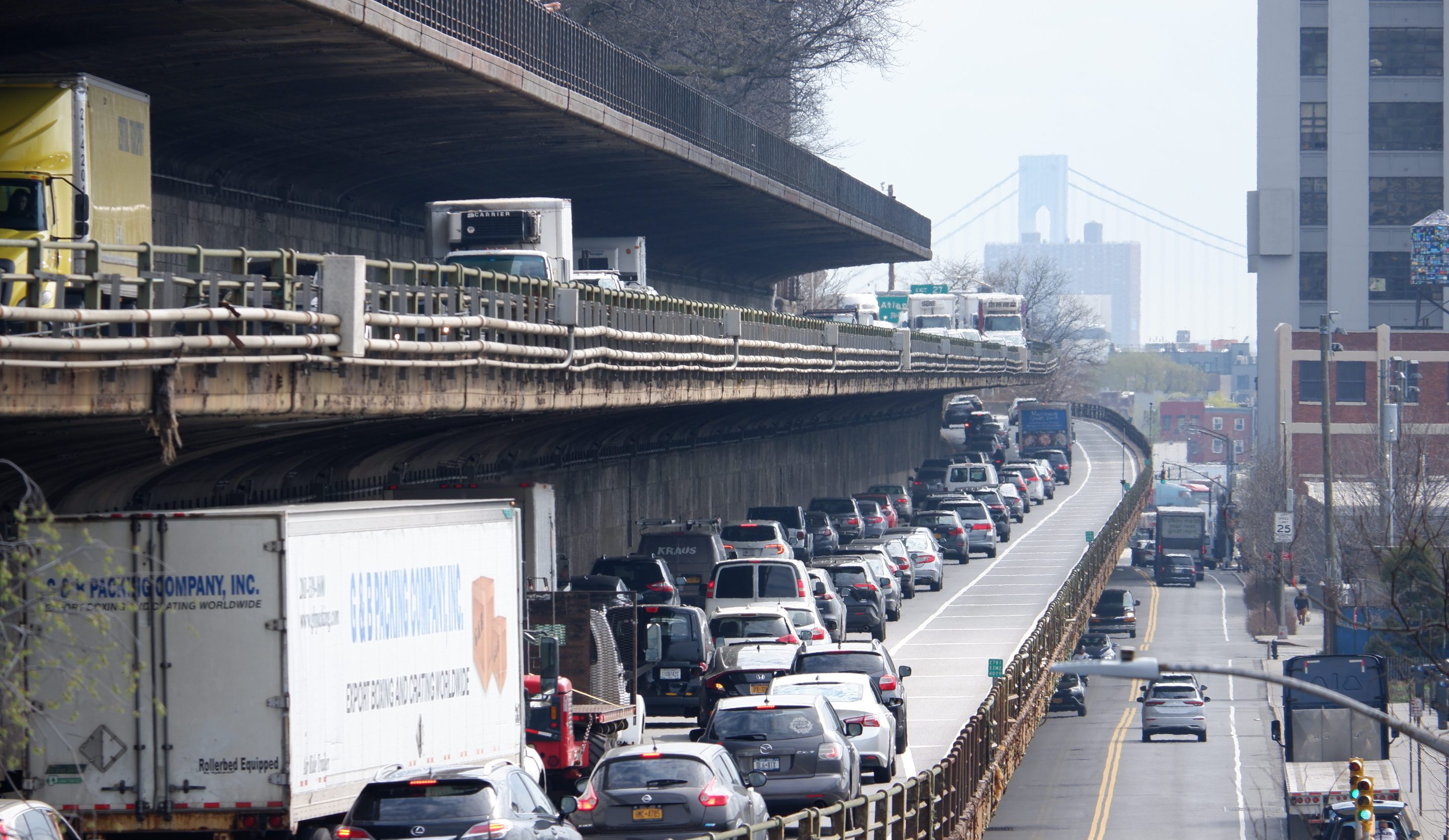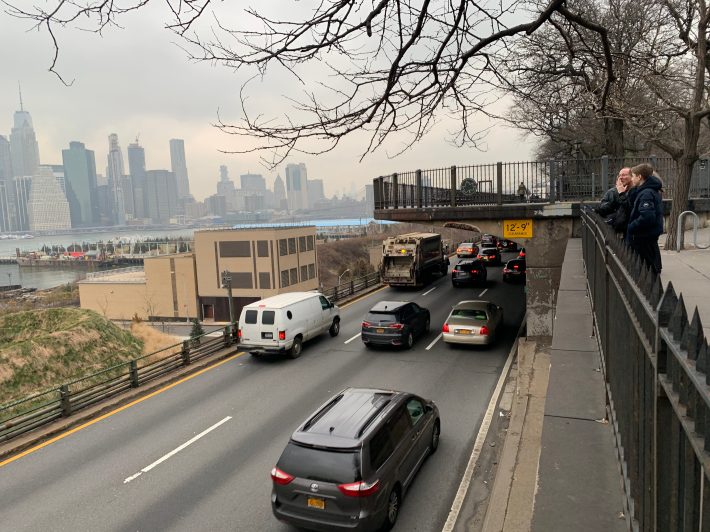City: BQE Must Be Rebuilt to Last a Century … To Prevent More Pollution
Paging Mr. Orwell: Doubling down on the Robert Moses highway is actually good for neighborhoods nearby, the city claims.
12:03 AM EDT on March 21, 2024

The BQE triple-cantilever.
War is peace. Freedom is slavery. Highways reduce pollution.
This Orwellian logic underpins the reason that the Adams administration says it must rebuild the Brooklyn-Queens Expressway to last for another 100 years, arguing that if the highway falls apart, 13,000 trucks will descend every day on low-income neighborhoods streets — an argument that was not only rejected by the federal government, but also the environmental justice communities it purports to serve.
The city Department of Transportation claims that pollution in neighborhoods lining the highway could increase by nearly 50 percent if the crumbling triple cantilever section between Atlantic Avenue and Sands Street is not rebuilt at a cost of $5.5 billion, according to the city's failed application for $800 million in Biden infrastructure bucks [PDF].
But environmental advocates called out the agency for creating a new boondoggle to entrench rather than undo one of Robert Moses's greatest crimes against urbanism.
“We unequivocally reject the use of environmental justice communities' suffering to justify the expansion of the causes that created the conditions we face today,” Rami Dinnawi, policy manager at El Puente, said in a statement. “We believe that any infrastructure that increases and promotes the proliferation of polluting vehicles is a harm to environmental justice communities and not a relief/mitigation."

The South Williamsburg organization is one of several along the BQE corridor seeking to hold the city accountable as it eyes widening the highway.
The Federal Highway Administration rejected DOT's application for a Multimodal Project Discretionary Grant last year, though officials at both levels of government declined to comment to say why. But the city's argument that rebuilding the highway would reduce pollution in neighborhoods that have suffered for decades certainly raised eyebrows.
The agency made the standard request of civic groups, in this case on its so-called Community Visioning Council, to support the bid — but didn't show the groups the full application, members of the organizations told Streetsblog.
The behind-the-scenes effort prompted enough concern for more than a dozen of the organizations to urge Gov. Hochul to step in to what they said was a “predetermined” plan.
‘For the next century’
DOT is poised to again seek construction funding support, but its application documents give insight into the city’s arguments for spending huge sums on maintaining the highway that for decades has cut through dense residential neighborhoods — a relic of a bygone age whose lifespan the transportation agency hopes to extend even longer.
Without the project, the agency says it will have to close the deteriorating 1.5-mile stretch by 2036.
“Reconstructing BQE Central is essential to ensure that this section of the highway will continue to be usable, with modern safety standards, for the next century,” wrote the DOT. “If left unimproved, State of Good Repair issues will force the city to introduce significant weight restrictions in the near term and consider permanent closure in the medium-term, displacing 13,000 daily trucks onto local streets.”
The cantilever currently carries 130,000 total vehicles every day, many of which would end up on neighborhood streets, increasing emissions by 40-49 percent, spewing harmful chemicals like nitrogen oxides, sulfur dioxide and particulate matter, according to DOT.
But the agency also said that a new 100-year lifespan for the BQE would “allow the city to investigate long-term strategies to improve conditions and reduce transportation disadvantage in Disadvantaged Communities, whereas a full closure would substantially add to burdens that these communities already endure."
It is true that the Big Apple is far too dependent on trucks, with 90 percent of goods entering by truck, well above the national average of 70 percent. And the BQE is currently a key freight corridor.
And maintaining the current structure is eating up DOT’s capital construction money, the agency argues. Work on the 21 structures of the 0.4-mile cantilever accounts for 30 percent of the agency’s $17 billion, 10-year capital budget for bridges, despite being just 14 percent of 150 spans that need repairs, according to the document.
The BQE is one of a handful of major projects “consuming all the capacity” of the city’s debt, budget director Jacques Jiha recently told the Council during an oversight hearing, Politico reported.
'Why on earth?'
Experts — including former DOT officials — questioned the agency’s rationale, saying that threats of carmageddon are routinely overblown, and that cementing the highway undermines the city’s goals of reducing car use and disincentivizes moving freight by rail, water, and smaller vehicles.
An expert panel on the BQE appointed by former Mayor Bill de Blasio recommended in early 2020 to reduce reliance on trucks by, for example, changing state law to allow small trucks onto the Belt Parkway — a more direct connection to the major cargo hub at JFK Airport — building a long-awaited cross-harbor rail tunnel, and resuming historic use of the city’s waterways as shipping corridors.
Expanding use of the so-called “Blue Highways” has been slow; last year, the city said it was looking to use a rebuilt Downtown Manhattan Heliport to take goods from boats ... by mid-2029.
“The city has an aggressive plan to reduce our embarrassing over-dependence on trucks to deliver freight by relying instead on our underused waterways, rail, and smaller environmentally friendly delivery vehicles,” said former DOT Commissioner Hank Gutman. “Why on earth would the DOT assume that all those efforts will fail? Any plan for the BQE should be a transition to that future, rather than a bet against it.”
Some traffic on the BQE is induced there because it allows drivers to bypass tolls of the New Jersey Turnpike and it connects to the free East River bridges rather than the paid tunnels. As a result, not all of the excessive traffic on the roadway would end up on nearby surface streets if the roadway was decommissioned, said Jon Orcutt, a former policy director at DOT, citing the flip side of the principle of "induced demand."
“People aren’t idiots, they aren’t going to drive along Third Avenue because the BQE used to be there. They might take a completely different route,” said Orcutt, who now advocates for Bike New York. “The whole thing about having a highway like the BQE there is it concentrates traffic dramatically.”
However, “Gridlock” Sam Schwartz, who served as the city’s Traffic Commissioner in the 1980s, agreed with DOT’s assessment. Even though some traffic would likely go away, closing the triple cantilever would still send traffic onto local truck routes like Caton Avenue and Linden Boulevard in Central Brooklyn, causing more pollution and endangering residents along those corridors.
“That traffic will be on the city streets if you don’t have the BQE,” Schwartz said. “I can’t imagine a road more in need of investment than the BQE triple-cantilever.”
Mayor change
De Blasio in 2021 ordered DOT to restripe the cantilever from three lanes in each direction to two to lessen the load, as part of a plan to shore up the roadway for another 20 years with waterproofing and spot repairs.
The mayor hoped that would buy planners time to devise a long-term solution for moving away from relying so heavily on trucks for freight movement, and reimagining the larger BQE corridor.
But Mayor Adams seized upon a pandemic-era influx of federal infrastructure funding — a “once-in-a-generation opportunity” as he put it — to repair the triple cantilever and expand the highway's footprint.
The massive project has also drawn interest among political power brokers, including Adams attaché Frank Carone and former Brooklyn Democratic Party boss Frank Seddio.
The new City Hall has criticized de Blasio’s lane reduction, chalking up congestion in nearby neighborhoods to the reconfiguration (see slides 110 and 111 here). But officials have also refused to implement expert recommendations to mitigate traffic jams and cut-through trips by closing or limiting busy highway ramps, such as at the Atlantic Avenue interchange.
In the application to the feds, DOT admitted that the lane reduction was actually beneficial — confirming Streetsblog’s previous reporting — saying it “reduced traffic volumes.” [Emphasis added.]
DOT is still conducting a traffic analysis comparing three versus two lanes on the cantilever, ahead of a larger environmental review of the BQE project.
Schwartz said the city should definitely not rebuild the highway with three wide lanes, which would be wider than the original highway. That would draw even more traffic to the area.
"Two good lanes comes pretty close to the capacity of the three lousy lanes that were on the BQE prior," Schwartz said. "The three lanes is an increase in capacity over what we had there before."
Meanwhile, the state Department of Transportation, which controls 88 percent of the highway’s Brooklyn portion, has “no plans” to redesign its sections of the roadway, which go through more blue-collar neighborhoods like Red Hook, Sunset Park, and the Southside of Williamsburg.
The groups that asked Hochul to intervene in last year — led by El Puente, UPROSE, the New York City Environmental Justice Alliance — have begun organizing under the moniker BQE Environmental Justice Coalition in an effort to hold both the city and state accountable across the entire BQE corridor in Brooklyn and Queens.
The group plans a formal launch next month.
🗓️ Save the Date! Join us for the public launch of the Brooklyn-Queens Expressway Environmental Justice Coalition!
— El Puente (@elpuentepalante) March 11, 2024
We'll be coming together to champion comprehensive, community-led plans to transform the BQE corridor into a more equitable and resilient space for all. pic.twitter.com/oFVfh78S1H
Dinnawi, of El Puente, said the coalition will work to ensure the city and state don't repeat the mistakes of the past with the incoming billions for the highway.
“If you are going to draw down $1 billion, you have to think 50 years ahead, not just fixing a crumbling infrastructure,” said Dinnawi.
A DOT spokesperson said that the agency still plans to tap into federal funding to fix the BQE rather than waste more money on maintaining the “outdated structure.”
“We are grateful to our federal and state partners on this project, and to the many communities that continue to provide feedback as we work for the best possible project for Brooklyn and for our city. This is only the beginning,” said Anna Correa.
Kevin Duggan joined Streetsblog in October, 2022, after covering transportation for amNY. Duggan has been covering New York since about 2017 after getting his masters in journalism from Dublin City University in Ireland. After some freelancing, he landed a job with Vince DiMiceli’s Brooklyn Paper, where he covered southern Brooklyn neighborhoods and, later, Brownstone Brooklyn. He’s on Twitter at @kduggan16. And his email address is kevin@streetsblog.org.
Read More:
Stay in touch
Sign up for our free newsletter
More from Streetsblog New York City
Friday’s Headlines: Canal Street Follies Edition
Manhattan Borough President Mark Levine isn't happy. Plus other news.
Daylight Again: Bronx Community Board Backs Parking Ban at Intersections
The Boogie Down is down with daylighting!
Community Board Wants Protected Bike Lane on Empire Blvd.
Brooklyn Community Board 9 wants city to upgrade Empire Boulevard's frequently blocked bike lane, which serves as a gateway to Prospect Park.
The Brake: Why We Can’t End Violence on Transit With More Police
Are more cops the answer to violence against transit workers, or is it only driving societal tensions that make attacks more frequent?
Report: Road Violence Hits Record in First Quarter of 2024
Sixty people died in the first three months of the year, 50 percent more than the first quarter of 2018, which was the safest opening three months of any Vision Zero year.




